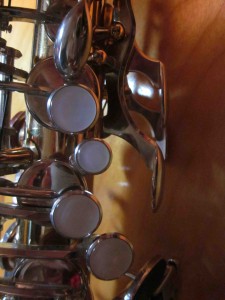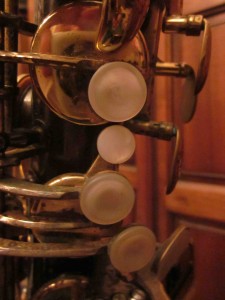Love his sound on clarinet! Been a fan for a while. I did start on clarinet before adding saxophone to what I play.
Still play clarinet sometimes, especially good since it’s portable for trips.
Enjoy!
Love his sound on clarinet! Been a fan for a while. I did start on clarinet before adding saxophone to what I play.
Still play clarinet sometimes, especially good since it’s portable for trips.
Enjoy!
By Neal 6 Comments
This video goes into the details of transposition. Let me know what questions you have or if parts don’t make sense.
To go from the key of C to the key of Eb (for alto saxophone and bari saxophone) you descend by a minor third or three half steps.
To go from the key of C to the key of Bb (for tenor saxophone and sorpano saxophone) you ascend by a whole step (major 2nd or two half steps).
Bb to Eb is a fourth or a fifth apart going up or down.
Got a question from Jerry the other day:
I’m very glad for your response to me and your concern too.I know already all the scale of my alto sax,even all the major scale.
The only thing that i don’t know. How to use it and to transpose to alto notes. The reason why I’m very interested to know this is bec.for my Music Ministry in the Church.
(The tenor/soprano saxophones are in “Bb”)
The music you want to transpose is very likely in “concert pitch” or the key of C.
That means if you play a “C” on your alto saxophone, it’s the same as an Eb on piano.
What’s the difference between C and Eb?
What’s the distance or interval between them?
C up to Eb is a minor third (three half steps). (Also, C down to Eb is a major sixth, but I usually don’t think of it that way)
Personally, I like to think about it as a minor third since it’s not as wide of an interval and the minor third is pretty familiar.
The note on alto or bari is down by a minor third compared to the concert pitch (piano, flute, etc), three half steps.
Eb on piano -> C on alto saxophone.
Db on piano -> Bb on alto saxophone
A on piano -> F# on alto saxophone
C on piano is A on bari.
Bb on piano is a G on bari.
Etc.
-Neal
By Neal 11 Comments
Just found a pretty cool online saxophone tuner.
Tuner
You need a microphone on your computer, the tuner itself is free.
Your computer will need a microphone – either built in or external.
If you want a portable tuner, here’s one.
I have a korg tuner and haven’t ever changed the batteries. It lasts for something like 85 hours.
You can also get apps that will do the same job. TE (Tonal Energy) is one that I have that is pretty good.
The tuner will name the note being played (in concert pitch).
It will tell you how close or far you are from being in tune on the note you’re playing.
A program that is very useful for learning music is called ‘Transcribe!’
You can loop sections and slow things down among other things.
Transcribe for Windows
Transcribe for Mac
By Neal 23 Comments
The blues saxophone line from before that I played on tenor, for alto!
I know it can be frustrating to have an entire combination of music (or whatever you’re learning) at full speed multiple times at the beginning of a lesson. Since this is only two bars, didn’t think that an issue. But let me know if you have questions!
So it plays three times at normal speed at the beginning. You could probably learn it by ear if you’ve some experience doing that or at least pick it up quickly once you see the written line.
When it’s slowed down, I’m just playing the notes, not with the rhythm of the line.
Note for beginning players:
On saxophone, you don’t play the same key with different fingers. Each finger has a specific role and may operate a single key or multiple keys. There aren’t ‘voicings’ which can be done different ways. I just play a little piano myself.
Check out the saxophone fingering chart if you’re confused on what the fingering diagrams mean.
By Neal 26 Comments
Here’s a short blues saxophone line. Something I heard a while back. Figured I would share it. Good to have music you can pull out whenever you want.
Listen, it’s also written, and slowed down note by note. Click the ‘share’ button if you like it! And leave a comment.
I play it on tenor sax, also recorded it on alto.
The line works over an A Minor chord, but could work in other changes as well. Play around with it. And I started on beat two, but you don’t have to!
Let me know what you think!
By Neal 2 Comments
Received this comment asking about an alto saxophone finger chart earlier today with regards to the saxophone finger chart.
 “Think this is lovely but i think this is for tenor sax. what of alto sax fingering chart! pls try and upload alto sax fingering chart for the sake of alto sax players. GREAT JOB!!!!!think this is lovely but i think this is for tenor sax. what of alto sax fingering chart! pls try and upload alto sax fingering chart for the sake of alto sax players. GREAT JOB!!!!!
“Think this is lovely but i think this is for tenor sax. what of alto sax fingering chart! pls try and upload alto sax fingering chart for the sake of alto sax players. GREAT JOB!!!!!think this is lovely but i think this is for tenor sax. what of alto sax fingering chart! pls try and upload alto sax fingering chart for the sake of alto sax players. GREAT JOB!!!!!
So, just to make it perfectly clear.
The fingering chart for saxophone works for alto, tenor, soprano, baritone, bass, contrabass, sopranino, soprillo, c melody, etc.
There are minor variations (high F# key, low A key, etc). But overall, the fingering system for all saxophones is the same.
So check out the saxophone finger chart.
You’ll need to enter your name and email address to receive the password to see the entire chart.
The great Michael Brecker on tenor sax.
Playing in 1998, Round Midnight written by Thelonious Monk
Leverkusener Jazztage
By Neal 6 Comments
Received a question about saxophone technique.
 Hi Neal
Hi Neal
I hope this e-mail finds you doing well.
I have a question for you if you have time?
I’m working on slurring, when I go from D to C even though I have released the octave key sometimes I still get the high C? If I tongue the note it doesn’t happen. It seems the sound wave if not broken holds the octave key down??
Could my horn be haunted? Ha Ha!
Is that normal, is it me or the horn? It is not happening all the time. Maybe water in the octave pip?
Take care thanks for your time.
Tim
My response:
Hey Tim,
That’s actually a very good question that you’re asking.
It’s probably not a haunted saxophone or water in the pipe.
You can actually play up an octave from the low notes very easily without using the octave key. You can even play up two octaves or more. We can this playing the harmonic series, also known as ‘overblowing’ sometimes.
When you tongue in between notes, you create a space that allows you to ‘reset’ everything. So pretty much anything will come out cleaner as opposed to slurring it.
You’ll learn a lot by slurring through the music about your technique though.
Going from C to D involves a lot of fingers. Not just one, like going from G to A or something like that.
Are all your fingers moving perfectly in sync?
Probably not.
Slow things down and try and figure out what you’re doing and you’ll be on your way to fixing the problem.
Let me know how it goes.
-Neal
By Neal 2 Comments
Dexter Gordon on tenor saxophone in Belgium. Lady Bird by Tadd Dameron (written in 1947).
January 8, 1964
George Gruntz on piano
Guy Pedersen on bass
Daniel Humair on drums


Want to play saxophone, but feeling lost and not sure how to get started?
In this online/downloadable class you will see methodical lessons in a sequence and you can get feedback and ask questions at any point.
Learn more
Want to take your playing to the next level?
You’ll learn fundamental saxophone skills, building past the basics. Master rhythms. Learn about phrasing, tone, and more. Here you will get feedback which is crucial to developing good habits.
Learn more